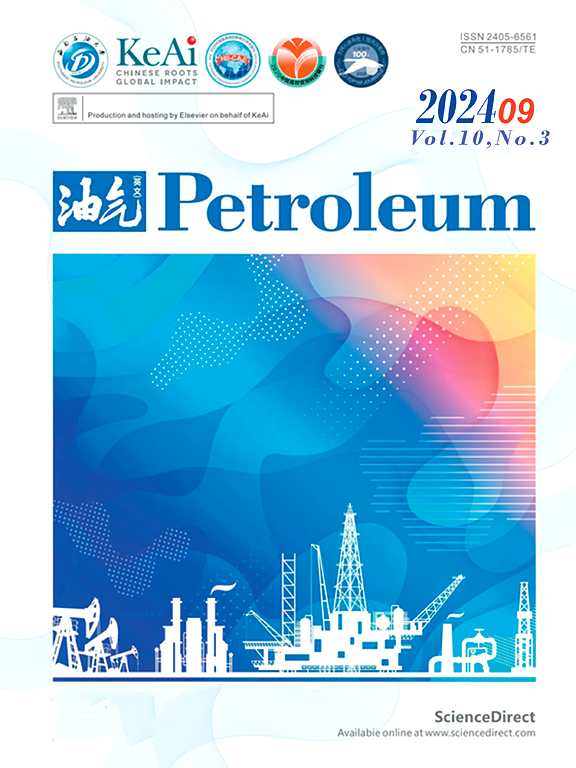Rapid screening and optimization of CO2 enhanced oil recovery operations in unconventional reservoirs: A case study
IF 4.2
Q2 ENERGY & FUELS
引用次数: 0
Abstract
CO2 injection not only effectively enhances oil recovery (EOR) but also facilitates CO2 utilization and storage. Rapid screening and optimization of CO2-EOR operations is urgently needed for unconventional reservoirs. However, it remains challenging due to a limited understanding of fluid flow in multiscale porous media and the problem complexity invoked by numerous factors. This work developed a new interpretable machine learning (ML) framework to specifically address this issue. Three different methods, namely random forest (RF), support vector regression (SVR), and artificial neural network (ANN), were used to establish proxy models using the data from a specific unconventional reservoir, and the RF model demonstrated a preferable performance. To enhance the interpretability of the established models, the multiway feature importance analysis and Shapley Additive Explanations (SHAP) were proposed to quantify the contribution of individual features to the model output. Based on the results of model interpretability, the genetic algorithm (GA) was coupled with RF (RF-GA model) to optimize the CO2-EOR process. The proposed framework was validated by comparing the GA-RF predictions with simulation results under different reservoir conditions, which yielded a minimum relative error of 0.34% and an average relative error of 5.3%. The developed interpretable ML method was capable of rapidly screening suitable CO2-EOR strategies based on reservoir conditions and provided a practical example for field applications.
非常规油藏CO2提高采收率的快速筛选与优化:一个案例研究
注入二氧化碳不仅能有效提高采收率,还能促进二氧化碳的利用和储存。非常规油藏迫切需要快速筛选和优化CO2-EOR作业。然而,由于对多尺度多孔介质中流体流动的理解有限,以及许多因素引起的问题复杂性,这仍然具有挑战性。这项工作开发了一个新的可解释机器学习(ML)框架来专门解决这个问题。采用随机森林(RF)、支持向量回归(SVR)和人工神经网络(ANN)三种不同的方法,利用特定非常规油藏的数据建立代理模型,RF模型表现出较好的性能。为了提高已建立模型的可解释性,提出了多向特征重要性分析和Shapley加性解释(SHAP)来量化单个特征对模型输出的贡献。基于模型可解释性的结果,将遗传算法(GA)与RF (RF-GA模型)相结合,对CO2-EOR过程进行优化。通过将GA-RF预测结果与不同储层条件下的模拟结果进行对比,验证了该框架的有效性,最小相对误差为0.34%,平均相对误差为5.3%。开发的可解释ML方法能够根据油藏条件快速筛选合适的CO2-EOR策略,并为现场应用提供了实际示例。
本文章由计算机程序翻译,如有差异,请以英文原文为准。
求助全文
约1分钟内获得全文
求助全文
来源期刊

Petroleum
Earth and Planetary Sciences-Geology
CiteScore
9.20
自引率
0.00%
发文量
76
审稿时长
124 days
期刊介绍:
Examples of appropriate topical areas that will be considered include the following: 1.comprehensive research on oil and gas reservoir (reservoir geology): -geological basis of oil and gas reservoirs -reservoir geochemistry -reservoir formation mechanism -reservoir identification methods and techniques 2.kinetics of oil and gas basins and analyses of potential oil and gas resources: -fine description factors of hydrocarbon accumulation -mechanism analysis on recovery and dynamic accumulation process -relationship between accumulation factors and the accumulation process -analysis of oil and gas potential resource 3.theories and methods for complex reservoir geophysical prospecting: -geophysical basis of deep geologic structures and background of hydrocarbon occurrence -geophysical prediction of deep and complex reservoirs -physical test analyses and numerical simulations of reservoir rocks -anisotropic medium seismic imaging theory and new technology for multiwave seismic exploration -o theories and methods for reservoir fluid geophysical identification and prediction 4.theories, methods, technology, and design for complex reservoir development: -reservoir percolation theory and application technology -field development theories and methods -theory and technology for enhancing recovery efficiency 5.working liquid for oil and gas wells and reservoir protection technology: -working chemicals and mechanics for oil and gas wells -reservoir protection technology 6.new techniques and technologies for oil and gas drilling and production: -under-balanced drilling/gas drilling -special-track well drilling -cementing and completion of oil and gas wells -engineering safety applications for oil and gas wells -new technology of fracture acidizing
 求助内容:
求助内容: 应助结果提醒方式:
应助结果提醒方式:


